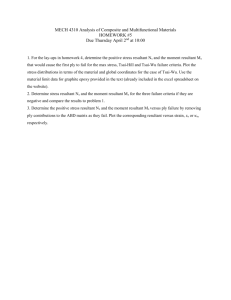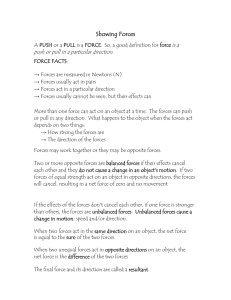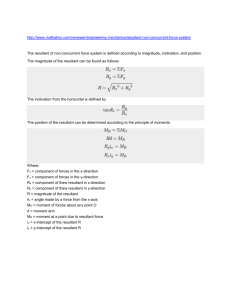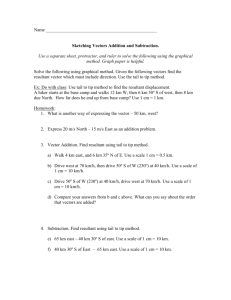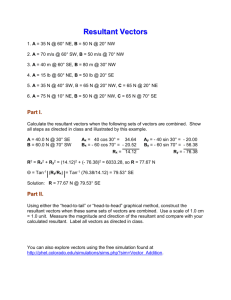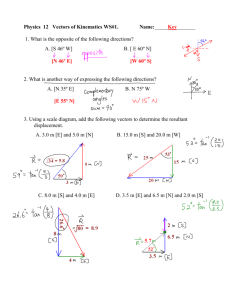Vector Addition Worksheet #2
advertisement
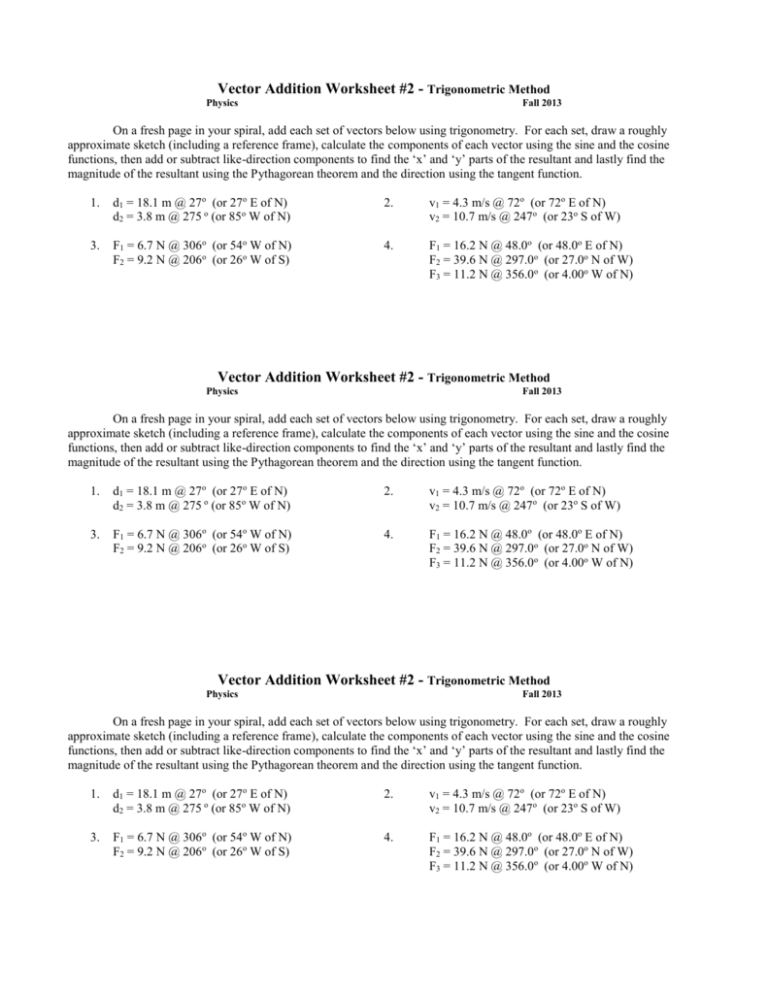
Vector Addition Worksheet #2 - Trigonometric Method Physics Fall 2013 On a fresh page in your spiral, add each set of vectors below using trigonometry. For each set, draw a roughly approximate sketch (including a reference frame), calculate the components of each vector using the sine and the cosine functions, then add or subtract like-direction components to find the ‘x’ and ‘y’ parts of the resultant and lastly find the magnitude of the resultant using the Pythagorean theorem and the direction using the tangent function. 1. d1 = 18.1 m @ 27o (or 27o E of N) d2 = 3.8 m @ 275 o (or 85o W of N) 2. v1 = 4.3 m/s @ 72o (or 72o E of N) v2 = 10.7 m/s @ 247o (or 23o S of W) 3. F1 = 6.7 N @ 306o (or 54o W of N) F2 = 9.2 N @ 206o (or 26o W of S) 4. F1 = 16.2 N @ 48.0o (or 48.0o E of N) F2 = 39.6 N @ 297.0o (or 27.0o N of W) F3 = 11.2 N @ 356.0o (or 4.00o W of N) Vector Addition Worksheet #2 - Trigonometric Method Physics Fall 2013 On a fresh page in your spiral, add each set of vectors below using trigonometry. For each set, draw a roughly approximate sketch (including a reference frame), calculate the components of each vector using the sine and the cosine functions, then add or subtract like-direction components to find the ‘x’ and ‘y’ parts of the resultant and lastly find the magnitude of the resultant using the Pythagorean theorem and the direction using the tangent function. 1. d1 = 18.1 m @ 27o (or 27o E of N) d2 = 3.8 m @ 275 o (or 85o W of N) 2. v1 = 4.3 m/s @ 72o (or 72o E of N) v2 = 10.7 m/s @ 247o (or 23o S of W) 3. F1 = 6.7 N @ 306o (or 54o W of N) F2 = 9.2 N @ 206o (or 26o W of S) 4. F1 = 16.2 N @ 48.0o (or 48.0o E of N) F2 = 39.6 N @ 297.0o (or 27.0o N of W) F3 = 11.2 N @ 356.0o (or 4.00o W of N) Vector Addition Worksheet #2 - Trigonometric Method Physics Fall 2013 On a fresh page in your spiral, add each set of vectors below using trigonometry. For each set, draw a roughly approximate sketch (including a reference frame), calculate the components of each vector using the sine and the cosine functions, then add or subtract like-direction components to find the ‘x’ and ‘y’ parts of the resultant and lastly find the magnitude of the resultant using the Pythagorean theorem and the direction using the tangent function. 1. d1 = 18.1 m @ 27o (or 27o E of N) d2 = 3.8 m @ 275 o (or 85o W of N) 2. v1 = 4.3 m/s @ 72o (or 72o E of N) v2 = 10.7 m/s @ 247o (or 23o S of W) 3. F1 = 6.7 N @ 306o (or 54o W of N) F2 = 9.2 N @ 206o (or 26o W of S) 4. F1 = 16.2 N @ 48.0o (or 48.0o E of N) F2 = 39.6 N @ 297.0o (or 27.0o N of W) F3 = 11.2 N @ 356.0o (or 4.00o W of N)

